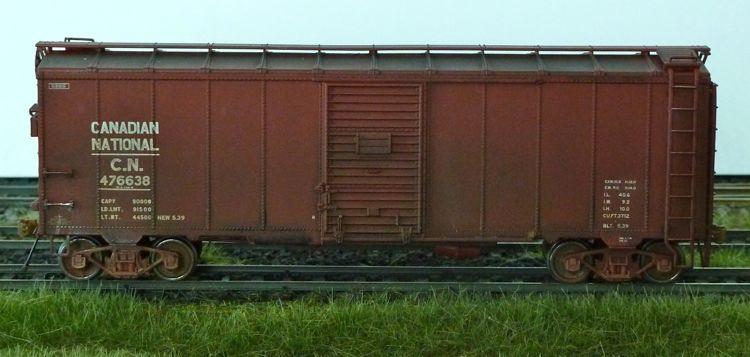Thought folks might be interested in seeing a Trueline car with some basic light weathering. Weathered to the left, fresh from box on the right.


Thought folks might be interested in seeing a Trueline car with some basic light weathering. Weathered to the left, fresh from box on the right.


As with most, my earlier freight cars were almost always kits. I had to build them so I did, but they could be a pain in the toosh and as my eyes find it harder to focus close up, the are more of a pain. I still build kits but not very often. But bottom line is I buy what I need to model freight cars that match those in photo’s during my era as best I can identify them. In the past 10 years, most of those freight cars have been R-T-R, so it’s not a matter of choice for me. I need 89’s TOFC flat cars, I’ve got Walthers kits, Accurail kits, and lots of Walthers flush deck RTR’s and some Atlas RTR’s. I need lots of SP box cars - the only correct cars are Athearn Genesis or RTR and Intermountain. ExactRail also releases alot of stuff I need. I have even built Eel River PC&F beer cars but they aren’t easy regarding the brake gear and the draft gear.
Cheers
Tom, thanks for that great list of sources. You did miss a couple of popular hobby store brands, but nevertheless, an impressive work.
I’ll offer the OP some more generic advice.
First of all, the mantra: it’s your layout. If it looks good enough to be on your layout, then it is. Period. No one can tell you differently. Some folks must have the utmost realism, for others, that’s too much of a bother. Both groups are right. So from my perspective, here goes the rest of the list.
Added on detail, whether factory or user applied, always looks better (that is, more realistic) than molded-on detail.
Paint that is crisp and clean, and lettering that is neat and legible, even the really small stuff, is better.
Metal wheels are preferable to plastic ones.
Kadee compatible knuckle couplers are preferable to other types, and within this distinction, couplers made out of metal (Kadee, Walthers Protomax) are better than plastic.
Body mounted couplers are better than truck mounted couplers.
Some models are generic designs which are just painted differently to represent different roads, and some actually have prototype-specific changes made for them (this is largely, but not exclusively, a passenger car issue).
So within these 6 areas (other users, feel free to add), you have to decide where your satisfaction level is. For instance, molded on detail like rivets, door latches, etc. (the ones that are more or less flush with the body) don’t bother me, but grab irons and windshield wipers do.
And this is the reason I generally buy all my rolling stock at the LHS or train shows. I like to see the detail and components for myself and see if it is worth what they’re asking for it.
One thing I’ve noticed a lot, both on model railroading forums and in contact with normal people is an aversion to what’s now called “eyewear”. When I was younger, I had great eyesight, especially for close-up work. As I got older, that was the part of my vision that began to deteriorate first and it was extremely frustrating, to the point that I didn’t hesitate to acquire proper eyeglasses. Because my vision for distance was still good, my optometrist suggested bifocals, with the top part non-prescription. This worked out really well (I didn’t have to make much adjustment, admittedly, as I had to wear safety glasses at all times at work), and I could wear the prescription glasses all the time, too. My distance vision is still pretty good, but the close-up part continues to slowly degrade, so I need to renew the glasses every few years. For real close-up work, glasses for everyday use are not always adequate, but I’ve found an Opti-Visor to be a useful adjuvant in my workshop. When required, I also use a jeweller’s-style loupe. If you need (or want) to do close-up modelling work, equip yourself with the proper tools - they will make the job all the more enjoyable and the quality of your work will improve. And even if you no longer build kits, you’ll enjoy the appearance of your r-t-r models even more.
You’re right: